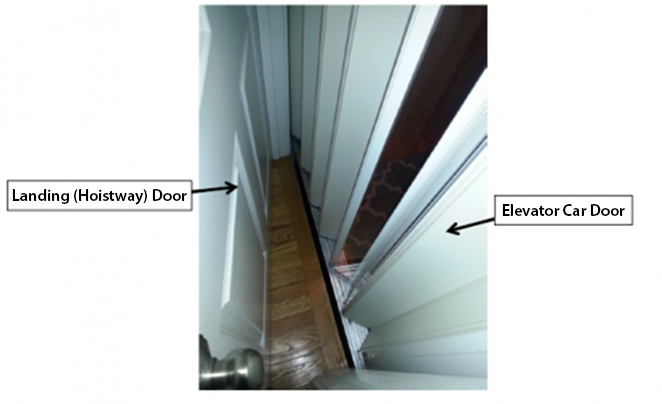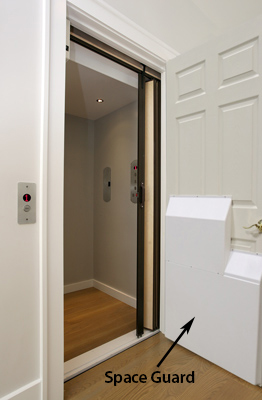1. What does a landing/hoistway door look like on a home elevator?
A landing door (also known as a hoistway door) is a hinged door that may look like other doors in your home. Many home elevators are installed with these types of doors, often by the home contractor or builder, and they may be automatically or manually operated. The elevator car will also have a door or gate attached to it that is supplied by the elevator manufacturer. The elevator car door operates manually or automatically. These doors are identified in the photo below.

2. What space gap are we talking about?
The important measurement to take is the distance between the inside of the landing door and edge of the landing sill (the beginning of the “running clearance” which is the space between the landing and the elevator cab). These are identified in the photo below.

3. What is a space guard?
A space guard is a safety device that attaches to the inside of the landing door and reduces the space gap between that door and the elevator car door or gate. Space guards vary depending on the size required but generally look like this picture when installed.
4. Why do I need to measure the space gap?
If the landing door is installed too far away from the elevator car door, the extra space can pose an entrapment hazard for children. Measuring this space will determine the appropriate size for your space guards.
5. What can I do if I cannot measure the space gap?
First, watch the 1 minute video on how to measure. If you are still unsure, you can contact the elevator manufacturer for assistance over the phone, which includes two-way video assistance.
6. How do I order a space guard?
Please submit the online form. The manufacturer will need information about your elevator model, serial number/job number of your elevator and the measurements you took of your space gaps. Any space guards will be sent free of charge directly to your home.
7. What should I do in the meantime, before I have installed the space guard?
The space guard is a safety device to prevent child entrapment. These types of entrapment incidents have caused serious injury and death to young children. Therefore, never let children play with your elevator. You can continue to use your elevator as long as you are mindful of children and do not allow them to use the elevator without an adult.
8. What should I do if I have difficulty installing the space guard?
First, watch the short video that provides step-by-step directions. If you need further assistance, you can contact the elevator manufacturer for assistance over the phone. Two-way video assistance and assistance with space guard installation will be provided on request.
9. I don’t have children; do I still need the space guard?
Yes. You should remove the potential hazard for children who many visit your home, or if the home is resold one day.
10. Why don’t I need to measure the space to the actual closed elevator door or gate?
That measurement is not necessary because the manufacturer will know the specific gate that has been installed on your elevator using the serial number/ job number you provide. The manufacturer will be able to validate measurements based on your specific gate/door.
11. My elevator was inspected (by a state/elevating authority) or receives an annual inspection, do I need to take action now?
Yes. The inspections will not address the hazardous gap that is the subject of this recall. Please contact your manufacturer in case you have any concerns about your installation and to verify the measurements.
12. If my elevator has flush-mounted doors, do I need to take action?
If your flush-mounted doors were installed with a maximum of 3/4″ between the inside of the landing door and edge of the landing sill, as demonstrated in the illustration below, you do not need a space guard. To check this measurement, see FAQ number 2 and watch the 1 minute video on how to measure. If you are still unsure, you can contact the elevator manufacturer for assistance over the phone, which includes two-way video assistance.
13. My elevator has sliding doors at the landings, do I need to take any action?
No. This issue only applies to swing-style landing doors (see FAQ number 1).
14. I don’t know what company manufactured my elevator, what do I do?
There is a page for each of three major manufacturers of home elevators on this web site. There are photos and helpful information to assist you in identifying the manufacturer of your elevator. Often, the easiest way is to locate the controller/control box or hydraulic equipment to find any labels that will list the manufacturer. You can also check with your home builder if you purchased the home with the elevator. Assistance is available if you need help identifying your elevator.
15. How do I find the manufacturer of my elevator?
Check on the cab operating panel (COP) inside your elevator cab, or the elevator controller, hydraulic equipment or control box of the elevator for any labels. Often you will find a contact phone number listed for the elevator manufacturer. If you cannot locate any labels, you can call one of the three manufacturers listed on this website to see if they can assist you to identify the manufacturer and how to contact them.
16. What if the manufacturer is not one of the three listed on this web site?
The door gap issue applies to all home elevators with swing style doors. It is recommended you contact the manufacturer, installation or service company of your home elevator directly, even if your elevator is not manufactured by one of the three companies listed on this web site, to ensure that your elevator does not have a gap that creates an entrapment hazard to children.

